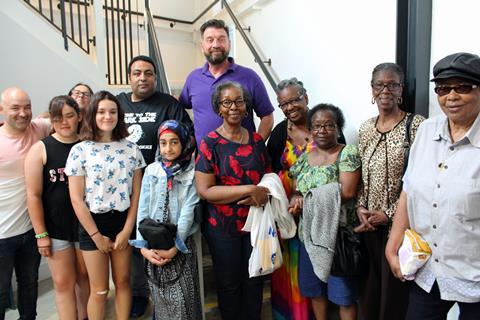The scale and sensitivity of our latest build required a different approach to usual, says executive producer Robi Dutta
DIY SOS has grown over the seven years since it became the Big Build. We still often build extensions, but have also built community centres and done up a street of derelict houses. We have looked at issues such as young people leaving care, gay parents, mental health, young carers, adopting disabled children, and veterans.
Nick Knowles and I went down to the Grenfell site with no cameras, and started talking to people on the ground. The effort by so many kind volunteers was inspiring.
BBC popular factual head David Brindley was really supportive of doing something if we could find the right project. Housing was too big a task, but it turned out that in the lower floors of the tower were different community spaces, including a gym for the Dale Youth Boxing Club, which is teaches any young person who wants to train about manners and discipline as much as the sport itself.
The club needed a home, as it was squatting in a gym in a disused car park with no heating or showers. Mick and Gary, the two inspiring trainers who are like dads to the people they coach, were only too happy to meet and take up a potential offer of a new club.
We found an empty plot and pitched our proposal to the Westway Trust, which managed it. They suggested a different, bigger plot under the Westway A40 flyover.
We then wondered if we could do two buildings at the same time on the 750 square metre site. Talking to locals, it was clear that there weren’t enough low-cost community spaces in the area. We went back to the channel to pitch the idea of a two-part series.
Most people have to get access and film their story; we had to do that and organise and build two huge buildings as well. The scale was enormous, more than twice the size of anything we had attempted before. Normally, we build a home extension; this was two buildings and, in a first, steel construction.
We pumped our contacts book and ended up with one of the country’s biggest construction firms on board, which took on the role of project manager. We drew up plans and a materials list and it just seemed to keep rolling. But it has been far from a smooth ride. There were many days when it looked like the whole thing was going to collapse.
Many people were suspicious and angry and we thought it was important to reflect that in the programme, even if it’s not very DIY SOS.
What we were asking for were enormous commitments - £100k+ of steel, for example. Carillion happened and we lost some companies. Up and down. Up and down. And many sleepless nights.
The community around Grenfell is understandably traumatised and access wasn’t always straightforward. Many people were suspicious and angry and we thought it was important to reflect that in the programme, even if it’s not very DIY SOS.
These two programmes have a different tone to usual, to be respectful of what had happened. No triumphalism, no big opening clapping, different music, no end-piece to camera summary from Nick which might have sounded trite – we wanted local people to end the shows.
We met some amazing people along the way, the inspiring eloquent kids from Dale Youth and the pensioners from a West Indian dominoes club for example, all to hopefully tell different stories about Grenfell and the community around. And we also got a special visitor who watches the show back – Prince William.
In the end though, thanks to the enormous generosity of many companies, we built two buildings (the 280 square meter boxing gym was built in just nine weeks) through donations worth over £2 million.
When you start a project of this scale, you don’t know that it actually will happen. We are all a bit shocked that it actually did. This was thanks to an amazing, and small, team and a lot of help and luck.
Television still has enormous power.

- DIY SOS: Grenfell (2 x 60 minutes, BBC Studios) aired at 9pm on 5 and 12 September on BBC1. The epiodes are both available on BBC iPlayer. A version of this piece was first published on the BBC’s blogs site






























No comments yet